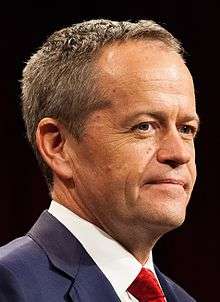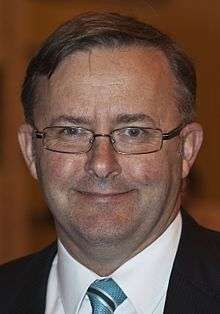Australian Labor Party leadership spill, October 2013
| | ||||||||||||||||||||||
| ||||||||||||||||||||||
| ||||||||||||||||||||||
| ||||||||||||||||||||||
The October 2013 Australian Labor Party spill was a leadership election held to select the next leader of the Australian Labor Party and Leader of the Opposition.[1] The spill resulted in Bill Shorten's election as Labor Leader.[2] Tanya Plibersek was later confirmed as deputy leader.[3]
The declared candidates were Bill Shorten and Anthony Albanese, who were both ministers in the outgoing Labor government.[4] Nominations closed on 20 September 2013.[5]
Under new rules, the new leader was elected by public members of the Australian Labor Party over a period of twenty days, followed by a ballot of the Labor parliamentary party. Each of these two voting blocs was weighted equally in determining the winner.
During the leadership election, Chris Bowen, former Treasurer of Australia and Member of Parliament for McMahon, was Interim Leader of the Labor Party and served as Leader of the Opposition.[6]
Background
After three years of instability in the Labor leadership in which four leadership spills were held between Kevin Rudd and Julia Gillard, this contest featured neither. Gillard retired from parliament at the election, while Rudd announced on election night that he would step down as Labor leader and return to the backbench in his concession speech at The Gabba in Brisbane following Labor's defeat.
Earlier in the year the ALP caucus approved changes to the way the federal parliamentary leader is chosen. The new rules make it more difficult to change leaders and require a ballot of the party membership on contested leadership spills.[7][8] The new rules encourage the parliamentary party to only nominate one candidate, to avoid a month-long ballot of the general party membership.[9] The new rules are controversial, however, and have been publicly criticised by ALP Senator Stephen Conroy and former Prime Minister Julia Gillard.[10][11]
Nominations opened at a parliamentary party meeting on Friday 13 September 2013, and remained open for a week. Anthony Albanese and Bill Shorten formally nominated.[6][12] As there was more than one nomination, a ballot of the parliamentary party and another of the organisational party were required.[6] The ballot of the organisational party lasted for two weeks.[6]
Process
Under the new Labor rules, nominations were open for one week beginning 13 September 2013. In order to be a nominated candidate, a nominee must receive the support of 20% of caucus.[13] After the conclusion of nominations, ballots were sent to grassroots party members, who had two weeks to return their ballots. On 10 October 2013, the caucus cast their vote for leader and the grassroots ballots were counted. The two voting pools were weighted 60/40 (Caucus having 60% of the final count) and the leader declared elected accordingly.[14]
Historically, the ALP have determined the members of cabinet (or shadow cabinet) in caucus, with the leader assigning portfolios.[15] This is unchanged, and the parliamentary caucus of Labor elected the executive at the same time they cast voters for leader. Only the election for the parliamentary leader involved the votes of grassroots party members.[13]
Originally only members of two years' standing were eligible to vote, but this was later widened to all ALP party members who were financial at 7 September 2013.[16]
Aftermath
With the leadership decided, caucus elections (without general party membership involvement) were held to determine the shadow ministry. In a return to ALP tradition, the shadow ministry were elected by caucus, with portfolio responsibilities to be assigned by the leader. Tanya Plibersek was elected as Deputy Leader. Anna Burke, Warren Snowdon and Laurie Ferguson complained publicly about the process.[17][18][19][20]
Candidates
Declared
- Anthony Albanese, former Deputy Prime Minister and deputy leader under Rudd[21]
- Supporters: Greg Combet[22] Jenny Macklin[23] Penny Wong[24]
- Bill Shorten, former Minister for Education, Employment and Workplace Relations[25]
- Supporters: Paul Howes,[23] Nicola Roxon, Kate Ellis, Peter Beattie, Mark Latham, Bob Carr, and Simon Crean
Declined
The following individuals ruled themselves out as candidates or were the subject of media speculation but did not stand:
- Chris Bowen, Interim leader and former Treasurer[26]
- Tony Burke, former Minister for Immigration[27]
- Bob Carr, former Minister for Foreign Affairs[27]
- Jason Clare, former Minister for Justice and Home Affairs[26]
- Tanya Plibersek, former Minister for Health[1]
- Wayne Swan, former Treasurer under Rudd and Gillard, deputy leader under Gillard[26]
See also
- Australian Labor Party leadership spill, 2010
- Australian Labor Party leadership spill, 2012
- Australian Labor Party leadership spill, March 2013
- Australian Labor Party leadership spill, June 2013
- Australian federal election, 2013
References
- 1 2 Kenny, Mark (9 September 2013). "Now search begins for leader to guide lost in the wilderness". The Age. Retrieved 10 September 2013.
- ↑ "Bill Shorten elected Labor leader over Anthony Albanese after month-long campaign". abc.net.au. 13 October 2013. Retrieved 13 October 2013.
- ↑ Packham, Ben (14 October 2013). "Tanya Plibersek endorsed by caucus to be deputy Labor leader". The Australian. Retrieved 14 October 2013.
- ↑ "Anthony Albanese puts his hat into the ring for Labor leadership". The Sydney Morning Herald. Retrieved 13 September 2013.
- ↑ "Anthony Albanese to run for Labor leadership against Bill Shorten". Abc.net.au. Retrieved 2013-09-14.
- 1 2 3 4 Cullen, Simon (13 September 2013). "How do Labor's leadership voting rules work?". abc.net.au. Retrieved 13 September 2013.
- ↑ Scarr, Lanai (22 July 2013). "Kevin Rudd gets caucus support for changes to electing Labor leadership after rowdy protesters greet him". news.com.au. Retrieved 10 September 2013.
- ↑ "Kevin Rudd wins Caucus support for Labor party reform at special meeting in Balmain". abc.net.au. 22 July 2013. Retrieved 10 September 2013.
- ↑ Kenny, Mark (10 September 2013). "Craig Emerson attacks Kevin Rudd as Labor looks to Bill Shorten as leader". The Sydney Morning Herald. Retrieved 10 September 2013.
- ↑ "Labor Senator Stephen Conroy labels Kevin Rudd's new leadership-selection rules a 'farce'". abc.net.au. 12 September 2013. Retrieved 12 September 2013.
- ↑ "Julia Gillard slams Labor leadership reform as contest between Bill Shorten and Anthony Albanese begins". abc.net.au. 14 September 2013. Retrieved 17 September 2013.
- ↑ Packham, Ben (10 September 2013). "Tony Burke urges Labor to stop arguing over Kevin Rudd". The Australian. Retrieved 10 September 2013.
- 1 2 "Prime Minister Kevin Rudd to propose major leadership reform to Labor caucus". News.com.au. 2013-07-08. Retrieved 2013-09-14.
- ↑ "How do Labor's leadership voting rules work?". Abc.net.au. Retrieved 2013-09-14.
- ↑ Johnston, Tim (29 November 2007). "Australia's new prime minister names his own cabinet". The New York Times. Retrieved 16 September 2013.
- ↑ Lion, Patrick (17 September 2013). "ALP opens the doors on leadership vote". The Mercury. Retrieved 17 September 2013.
- ↑ "Factional squabbles dog Labor as Jacinta Collins, Anna Burke vent anger". The Australian. 2013-10-15. Retrieved 2016-08-11.
- ↑ "Fraction too much faction in Labor 'cabal'". The Australian. 2013-10-15. Retrieved 2016-08-11.
- ↑ Oliver Laughland (2013-10-14). "Anna Burke: the faceless men still control Labor". theguardian.com. Retrieved 2013-12-28.
- ↑ "Tanya Plibersek endorsed by caucus as deputy Labor leader". The Australian. 2013-10-14. Retrieved 2016-08-11.
- ↑ Anthony Albanese to run for Labor leadership against Bill Shorten. Yahoo!7. 13 September 2013
- ↑ Karvelas, Patricia (17 September 2013). "Greg Combet to launch Anthony Albanese's Labor leadership campaign". The Australian. Retrieved 17 September 2013.
- 1 2 AAP (19 September 2013). "Bill Shorten tells Anthony Albanese: stop the sledging". The Guardian Australia. Retrieved 23 September 2013.
- ↑ "Greg Combet and Penny Wong back Anthony Albanese as he launches Labor leadership campaign". abc.net.au. 18 September 2013. Retrieved 23 September 2013.
- ↑ "Bill Shorten says he will stand for Labor leadership". Abc.net.au. Retrieved 2013-09-14.
- 1 2 3 Packham, Ben (9 September 2013). "Chris Bowen won't stand for Labor leadership". The Australian. Retrieved 10 September 2013.
- 1 2 "Bob Carr and Tony Burke reject Labor leadership roles". news.com.au. 10 September 2013. Retrieved 10 September 2013.

